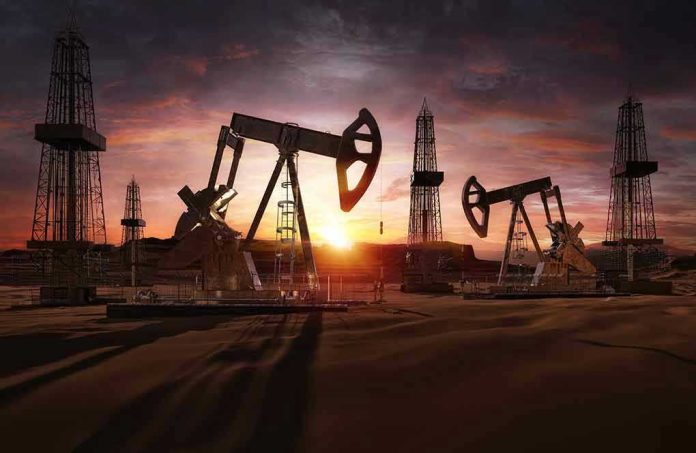
The Trump administration just proposed auctioning off 1.27 billion acres of U.S. federal waters for oil and gas drilling—the largest offshore expansion in American history—and it’s about to reshape the energy landscape, coastal economies, and environmental policy for the next fifteen years.
Quick Take
- The Interior Department unveiled a plan to open previously protected waters off California, Florida, and Alaska to oil and gas leasing through 2040
- Six lease sales are scheduled off California for the first time since 1984, with drilling also proposed in the eastern Gulf of Mexico near Florida
- Environmental groups warn of catastrophic oil spill risks, ecosystem destruction, and setbacks to climate commitments
- Over 80 percent of existing offshore leases remain non-productive, raising questions about whether new drilling is economically necessary
A Billion Acres: Understanding the Scale
When bureaucrats announce a “billion-acre” plan, most people’s eyes glaze over. But put it in perspective: that’s roughly 1.27 billion acres of federal waters targeted for oil and gas development. To grasp what this means, consider that California’s entire landmass covers only 164 million acres. The Trump administration is proposing to open an area roughly eight times larger than the entire state to offshore drilling. This isn’t incremental expansion—it’s a fundamental reshaping of American energy policy and coastal access.
Breaking the Moratorium: California and the Eastern Gulf
California hasn’t seen offshore lease sales since 1984—forty-one years of protection. That’s about to change. The plan schedules six lease sales off the California coast between 2027 and 2030. Simultaneously, the eastern Gulf of Mexico near Florida, an area with minimal drilling history, faces proposed lease sales in 2029 and 2030. These aren’t marginal adjustments to existing drilling zones. They’re incursions into waters that have been deliberately shielded from oil development for decades, largely due to environmental concerns and state opposition.
Florida’s tourism industry—worth roughly $112 billion annually—depends on pristine beaches and clear waters. An oil spill in the eastern Gulf could devastate not just the environment but the economic engine of the entire state. Yet the plan moves forward anyway, suggesting that energy production priorities now override coastal economic protection.
Alaska’s Arctic Frontier: Thirty Sales and Counting
Alaska faces the most aggressive expansion. The plan mandates over twenty lease sales in Alaskan waters through 2031, with additional sales continuing through 2040. This includes the High Arctic and Cook Inlet—ecologically sensitive regions home to indigenous communities that depend on marine resources for subsistence. The Deepwater Horizon disaster in 2010 killed eleven workers and spilled 4.9 million barrels of oil into the Gulf of Mexico. Arctic waters are far more hostile to cleanup efforts, meaning a spill there could cause exponentially greater damage.
The Paradox: Leases Without Production
Here’s where the logic breaks down. Oil companies currently hold over 2,000 active leases in federal waters. Yet more than 80 percent of those leases produce nothing. They’re held for speculative purposes or strategic positioning. Expanding leasing when existing leases sit idle raises a fundamental question: Is this about energy security or simply transferring public resources to private companies? The administration argues the plan enhances U.S. energy dominance, but the numbers suggest otherwise. Existing capacity remains underutilized.
The Legal Minefield Ahead
Environmental groups including Earthjustice, the Center for Biological Diversity, and Oceana are already preparing legal challenges. The National Environmental Policy Act (NEPA) requires detailed environmental impact assessments before major federal actions. The administration must demonstrate that the plan won’t cause unreasonable environmental harm. Given the plan’s scope and the targeting of previously protected areas, courts will likely scrutinize whether proper review occurred. Past drilling expansion proposals have been blocked or delayed through litigation.
The Climate Calculus
The U.S. is simultaneously negotiating international climate commitments while proposing its largest offshore drilling expansion. That contradiction isn’t lost on observers. Expanding fossil fuel extraction contradicts stated climate goals and undermines credibility in global climate negotiations. The plan locks America into decades of continued oil production when the energy transition is accelerating. Renewable energy costs have plummeted, battery technology is advancing rapidly, and electric vehicle adoption is accelerating. Betting heavily on offshore oil development in 2025 looks like investing in buggy whips after the automobile arrived.
Who Wins and Who Loses
Oil companies and their shareholders win. The plan guarantees access to new reserves and decades of production rights. Energy workers in oil-dependent regions gain employment opportunities. But coastal communities, fishing industries, tourism operators, and indigenous populations face the downside risks. A single major spill could devastate these economies for years. Tourism operators in Florida and California, fishing communities throughout Alaska, and indigenous subsistence hunters all have far more to lose than to gain.
Sources:
Trump Proposes Massive Expansion of Offshore Drilling in Public Waters – Earthjustice
Trump Offshore Drilling Plan Brings Oil Spill Risks to U.S. Coasts – Center for Biological Diversity
Interior Department Proposes Plan to Wreck America’s Coasts With Offshore Drilling – Oceana






